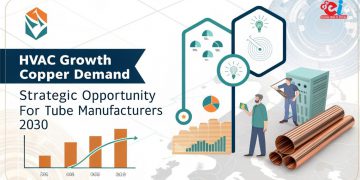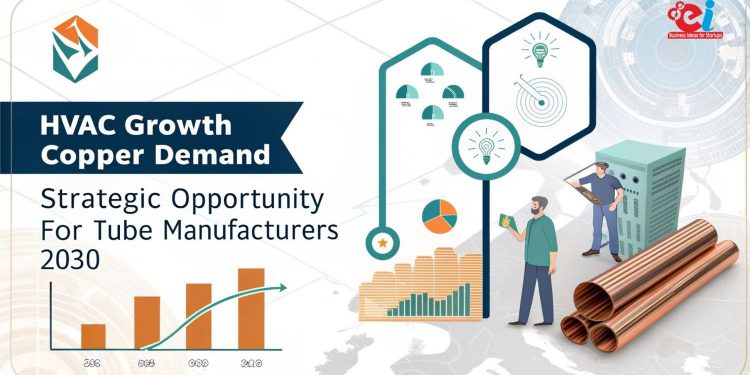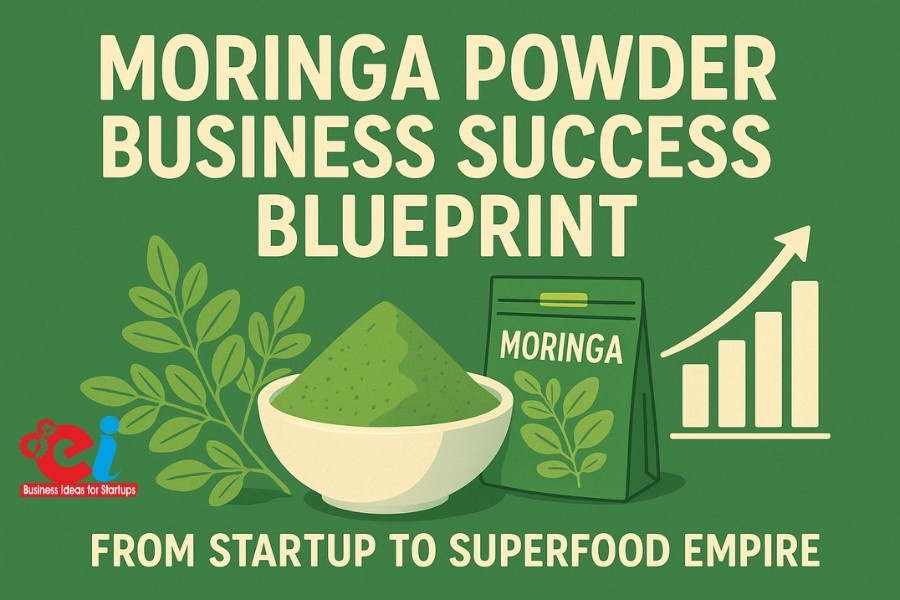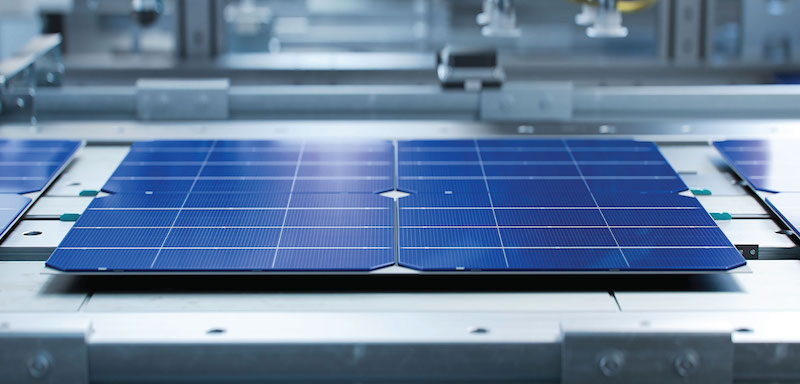The heating, ventilation, and air conditioning (HVAC) world is changing rapidly due to new technology, an increased focus on energy efficiency, urbanization, and rising global temperatures. Outstanding and reliable components that withstand high thermal stress are in demand now more than ever for buildings, industries, data centers, and vehicles. Withstandig components include those used in construction and production. This immense growth in construction and vehicles reliance on temperature control and clean air systems fueled the demand for copper tubes in these systems. Therefore, focusing on copper tubes for overcoming the high standards set throughout the industry will allow further growth in the HVAC sector copper tube manufacturers.
Copper tubes are integral to the operation of heat pumps, ventilators, air conditioners, chillers, and other HVAC appliances for refrigerant piping, structural efficiency, and heat transfer. Copper pipes offer the best choice due to their long life, corrosion resistance, and ability to conduct heat. Currently, the HVAC sector is attracting significant investment and offers ample opportunities for market share growth. Copper pipe manufacturers will benefit from the shift towards variable refrigerant flow systems, the strategic cooperation model, and product design innovation. The next ten years will be the most profitable for operational expansion and evolving product designs.
This article examines the intricate relationship between the expansion of HVAC systems and the increase in demand for copper tubes which provides strategic insights for manufacturers in India and worldwide. It also examines the evolution of the industry’s structure, technological parameters, investment shifts, and how business expansion can be achieved alongside sustainability capture gaps.
Estimating The Demand For HVAC Systems By 2030
Over 150 billion USD is how much the HVAC market is estimated to be currently worth, and it is predicted to surpass 300 billion USD by 2030. In India, the sector is estimated to grow with a double-digit CAGR on account of climate change, burgeoning real estate activity, and improvement in the attention paid to indoor air quality. Comprehensive urban development programs, Smart City initiatives, budget accommodation construction, and retail growth are all aiding the growth of HVAC. Further, there has been a shift in the design of workplaces and home post-pandemic, driving the need for air purification and ventilation, which is increasing the adoption of HVAC systems.
Commercial IT infrastructure spending in the Asia Pacific, as well as the Middle East and Africa, is booming, leading to an increase in the construction of malls, airports, hospitals, and IT parks that have high uses of HVAC systems. Along with the urban and semi-urban population being exposed to rising income levels, there has been a marked decline in the unit cost of air-conditioning, leading to increase usage.
This tremendous growth is encouraging HVAC OEMs to source for quality parts and dependable supply chains—most important being copper tubes, which are used for heat exchanging and refrigerant circulation within an air-conditioning or refrigeration unit.
Related: Construction Industry in India
Why Copper Tubes are Vital to HVAC Functionality
Copper exhibits superior characteristics for heat conduction, high pressure, corrosion resistance, and ease of fabrication. In HVAC systems, copper tubes are primarily used in condenser coils, evaporator coils, refrigerant lines, suction lines, and liquid lines. Furthermore, copper’s inherent antimicrobial qualities make it suitable for use in pathways of air-purification, especially in controlled environments such as hospitals or cleanrooms.
Copper possesses greater mechanical strength, lower permeability to refrigerants, and better temperature cycling resistance compared to aluminum. Additionally, copper is preferentially easier to join, bend, and repair—serving better under field condition servicability. These factors make copper tubes used in HVAC systems not just preferential, but often a necessity in some premium systems due to regulatory standards or performance needs.
Particularly with inverter based and VRF (Variable Refrigerant Flow) systems, the transition towards high efficiency HVAC equipment increases the necessity for high grade copper tubing with exact dimensional tolerances, precision pressure resistance, and heightened temperature cycling resilience.
Advancements in Copper Tube Technology
The copper tube industry is vibrant and dynamic. The development of modern processes within materials science results in inventions such as inner-grooved (rifled) copper tubes, multi-duct tubes, and ultra-thin wall tubes which maximize surface area to volume ratio for enhanced heat exchange through the use of minimal material and augmented surfaces. These innovations are especially popular in compact systems such as ductless mini-splits, automotive HVAC units, and energy-efficient window ACs.
Other manufacturers now rely on the use of high-speed extrusion, bright annealing, and seamless drawing to optimize production speed, quality, and increase the lifecycle of the tubes. Some manufacturers are developing special copper alloy tubes with superior strength and anti-vibration qualities for specialized HVAC applications.
The Indian market is still in the process of adopting these sophisticated variants, presenting a market gap for local manufacturers to provide enhanced products at lower costs and reduce reliance on imports. With the right investment in technology and research, Indian copper tube manufacturers have a promising opportunity in both domestic and international markets.
Outlook for Investment and Plant Setup on Copper Tubing
The manufacturing unit of copper tubing has a capital-intensive setup. However, this type of copper tubing has a high volume production potential and returns. A modern day copper tubing plant comes with facilities for rod casting or billet procurement, hot rolling or extrusion, cold drawing and finishing of tubes which includes annealing, straightening, quality control. Additional specialized machinery is often required for producing rifled or inner-grooved tubes that are in increasing demand from HVAC industries.
A mid-sized plant which has a capacity of about 10,000 to 5,000 tonnes per annum would typically require an investment of roughly over Rs. 50 crore to Rs. 100 crore. The cost of land as well as equipment origin, level of automation and their respective costs also influence the investment value. Unlocking doors in the strategic location such as Pune, Bhiwadi, Ahmedabad, or Chennai offer HVAC hubs.
Gas, power and water as far as utilities are concerned need to be highly dependable. Compliance with the set safety and environmental protection measures which include emissions control, waste recycling, and moderation is also a given. Industrial industry collaboration, such as with Niir Project Consultancy Services meticulously work to ensure that entrepreneurs obtain accessible detail project feasibility as well as vendor list, plant layout planning, and government incentive consultation.
Other services that NPCS provide include project planning documents, business registration, and enrollment along with tailored market forecasting models and production analysis.
Aligning with Sustainability and Energy Efficiency Goals
HVAC system manufacturers are responding to governmental and consumer pressures by incorporating greener technologies into their systems. Copper is one of the materials HVAC systems use because it enhances system efficiency while being recyclable and reusable without losing its quality, thus aligning with circular economy principles.
Refrigerants such as R-32 and R-290 are classified as low Global Warming Potential (GWP) refrigerants and enable the use of energy-efficient HVAC systems. Copper tubing is constantly in demand because it is able to withstand the high pressures these refrigerants use. Therefore, there is a greater need for high-performance copper tubes used in HVAC systems compatible with these newer refrigerants.
HVAC system manufacturers can reduce their carbon footprint by adopting clean production technologies and improving scrap recycling. These methods qualify manufacturers for certifications or export regulations like RoHS and REACH.
Indian manufacturers wanting to implement sustainable practices will be positioned stronger in advance of future regulations while simultaneously appealing to global HVAC OEMs seeking to reduce supply chain risks.
Market Entry and Growth Strategy
The most efficient method to penetrate and expand in the manufacturing of copper tubes business is to focus on HVAC industry integration. Develop partnerships with OEMs, AC assemblers, refrigerator manufacturers, and HVAC contractors as they form the backbone of the industry. Long-term contracts and preferred supplier status can be achieved by consistently meeting quality standards, offering custom tubing options, and providing technical assistance.
Establishing distribution centers in major cities and appointing dealers for aftermarket servicing and repair of HVAC systems opens up another stream of revenue. There is also potential for increased expansion through private label production for established brand names, and exports to developing HVAC markets throughout Africa, South Asia, and Southeast Asia.
An online presence, participation in international industry trade fairs, and attesting branding mark including compliance to local or international standards such as ASTM B280 or EN 12735-1 can further supplement strengthening brand awareness for international customers.
NPCS offers tailored strategies to such a go-to-market initiative with comprehensive market research, competitor analysis, buyer information, and supply chain modeling for strategic logistics, inventory, and planning.
Financial Viability and Long-Term ROI
Despite being capital intensive, the copper tube manufacturing business offers attractive returns once capacity utilization stabilizes. With global copper prices on the rise and HVAC demand expanding, the pricing environment remains favorable for value-added copper products. Manufacturers can protect margins through efficient scrap management, process optimization, and volume scaling.
Margins for standard copper tubes range between 8%–15%, while premium rifled and alloyed tubes can offer even higher profitability. The break-even period for a well-managed mid-sized plant is typically 3–4 years, with ROI exceeding 20% once full capacity is achieved.
With growing import substitution in India and government initiatives like PLI (Production Linked Incentive) for electronics and air conditioning components, domestic manufacturers can tap into incentives and duty benefits. NPCS can assist businesses in preparing bankable DPRs, investment proposals, and applying for MSME or export-related subsidies.
Conclusion: A Strategic Manufacturing Bet for the HVAC Decade
The HVAC industry’s unstoppable march toward growth, efficiency, and sustainability is laying a strong foundation for allied sectors. For manufacturers of copper tubes used in HVAC, the decade till 2030 offers a once-in-a-generation opportunity to scale operations, lead innovation, and become essential players in a high-demand, value-driven market.With a clear demand roadmap, proven product utility, and export potential, copper tube manufacturing stands out as a robust industrial venture. Entrepreneurs, MSMEs, and investors who act now—guided by professional advisory from Niir Project Consultancy Services—can position themselves as leaders in the HVAC component ecosystem, ready to serve the needs of a rapidly evolving global climate infrastructure.
Which business to start? How to choose a business idea?


























